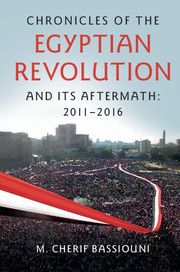Book contents
- Frontmatter
- Dedication
- Contents
- Preface
- Acknowledgments
- List of Abbreviations
- Introduction
- 1 The Early Stage of the Revolution
- 2 Mubarak Relinquishes the Presidency and the SCAF Assumes Power
- 3 A Prelude to Democracy: 2011–2012 Elections
- 4 The Morsi Presidency: June 30, 2012 to July 3, 2013
- 5 The Military's Return to Power and the El-Sisi Presidency
- 6 2015Legislative Elections and the Changing Civilian Political Landscape
- 7 The Military Institution: Its Power, Influence, and Culture
- 8 Violence and Repression
- 9 The Accountability Gap
- 10 The Justice System in Crisis
- 11 The Constitutional Quagmire
- 12 Demographics, Education, and the Economy
- 13 Geopolitical Factors
- 14 Concluding Assessment
- Pictures of the Egyptian Revolution and Related Events
- Bibliography
- Index
2 - Mubarak Relinquishes the Presidency and the SCAF Assumes Power
Published online by Cambridge University Press: 24 November 2016
- Frontmatter
- Dedication
- Contents
- Preface
- Acknowledgments
- List of Abbreviations
- Introduction
- 1 The Early Stage of the Revolution
- 2 Mubarak Relinquishes the Presidency and the SCAF Assumes Power
- 3 A Prelude to Democracy: 2011–2012 Elections
- 4 The Morsi Presidency: June 30, 2012 to July 3, 2013
- 5 The Military's Return to Power and the El-Sisi Presidency
- 6 2015Legislative Elections and the Changing Civilian Political Landscape
- 7 The Military Institution: Its Power, Influence, and Culture
- 8 Violence and Repression
- 9 The Accountability Gap
- 10 The Justice System in Crisis
- 11 The Constitutional Quagmire
- 12 Demographics, Education, and the Economy
- 13 Geopolitical Factors
- 14 Concluding Assessment
- Pictures of the Egyptian Revolution and Related Events
- Bibliography
- Index
Summary
THE WEEKS OF SUSPENSE
The two weeks leading up to February 11, 2011, when then-President Hosni Mubarak relinquished the presidency in favor of the SCAF, were filled with political suspense and drama – and human tragedy. Just as violence erupted in the streets so did behind-the-scenes political intrigue.
The street violence, as described above in Chapter 1 and in Chapter 8, first started on January 28 at the al-Gala’a and Kasr el-Nil bridges, where police used tear gas and buckshot against peaceful protesters heading to Tahrir Square from Giza and other areas. Had they been allowed to pass, the demonstrators probably would have remained peaceful. But the police response prompted still more violence.
After the first brutal confrontation of January 28 on these two bridges, the protesters overwhelmed the poorly trained and unmotivated rural conscripts of the Central Security Forces. By January 31, when the Muslim Brotherhood, the Salafists, and the hooligans had joined the protesters, violence was pervasive. The targets included police stations, prisons, the Ministry of Interior, Parliament, and other official buildings, as will be described in Chapter 8.2. Protesters seized weapons, released prisoners, and beat and killed police officers. The “hooligans” also joined the fray, though surely for different reasons. During the ensuing days, when the security forces killed an estimated 850 civilians, most of these killings were done by snipers who were police officers, but were not always in uniform and frequently wore masks. During that time, the Brotherhood, Salafists, and “hooligans” attacked public and private property including more than thirty police stations nationwide and two prisons, where they seized an unknown number of weapons and freed an estimated twenty-three thousand prisoners. Public and private property suffered significant damage, and the country was in turmoil. Many cities were bracing for chaos, as was the country as a whole. At the same time, the economy was in decline and expected to get worse. Facing the prospect of a near civil war at the street level, and the challenge of dealing with the remains of Mubarak's regime, the military was between the proverbial rock and a hard place.
- Type
- Chapter
- Information
- Publisher: Cambridge University PressPrint publication year: 2016

